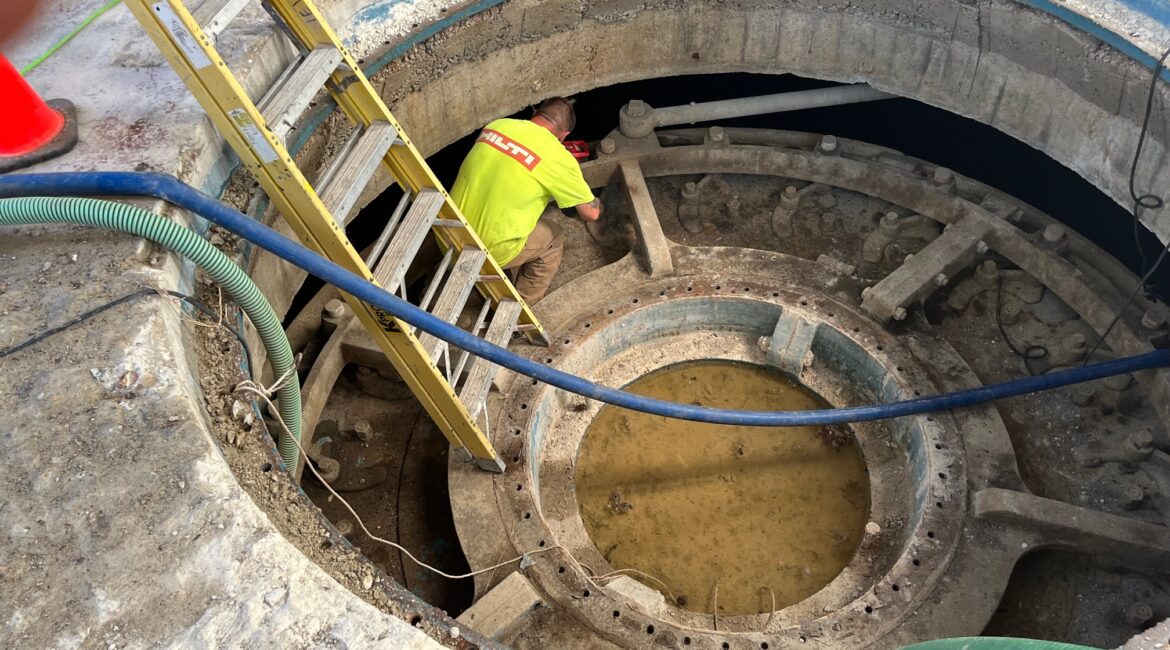By Kim McDarison
Work which was initially slated to begin in March is underway at the Indianford Dam, according to information shared by Rock-Koshkonong Lake District (RKLD) Board of Commissioners Chairman Alan Sweeney.
Work to replace two wicket gate carousels underneath the dam’s powerhouse began July 18, he said.
Work was delayed by high and fast moving water earlier this year at the dam, Sweeney noted.
The Indianford Dam impounds Lake Koshkonong, a more than 10,000-acre lake located in Jefferson, Dane and Rock counties.
The dam lies along the Rock River, some 5.5 miles downriver from the lake in Rock County. The powerhouse, which has been placed by the Wisconsin Historical Society on its Agriculture and History Inventory, is located on the west bank of the river. The powerhouse, according to the Wisconsin Historical Society, was built in 1928.
A link to the historical society’s inventory page is here: https://www.wisconsinhistory.org/Records/Property/HI84172.
The full dam includes the powerhouse, a spillway and six slide gates situated on the east side of the river.
The work that began earlier this month includes the removal of the submerged wicket gate carousels and replacing them with slide gates, similar to those operating on the river’s east side, which will be installed on the powerhouse’s north or upriver side.
Work further includes the addition of an interior staircase to allow workers access to the new gates.
Additionally, concrete curbs designed to help hold wicket gates in position will be removed from the cavity floor.
Concrete, held in place by I-beams, will be added between the two cavity ceilings and the powerhouse floor to help stabilize the system and keep water from entering the powerhouse, Sweeney said.
Wicket gates, power production, removal
The submerged wicket gate system at the Indianford Dam powerhouse is comprised of two concrete cavities underneath the powerhouse, each of which contains a carousel supporting levers or “vanes” that swivel on the carousel as water moves through. The system, combined with the dam’s spillway and slide gates on the dam’s east side, control the amount of water that moves through the dam.
According to a DNR document titled: “Environmental Assessment: On Petition of the Rock-Koshkonong Lake District Amend Order 3-SD-82-809, Regarding the Indianford Dam and Lake Koskinong Water Levels,” which was produced by the DNR in March of 2005, the Indianford Dam was built in 1851. The original structure consisted of rock-filled wooden cribs and earthen dikes, along with some masonry stone and a gristmill.
Over the years, the dam underwent several construction improvements.
According to the DNR’s document, an “era of dam reconstruction and dam heightening for power production” took place circa 1900 to 1939.
Wicket gates were installed as a means by which to harness the river’s power to produce electricity, the document stated.
The document further noted that power generation at the dam’s powerhouse, which was eventually owned by Wisconsin Power and Light, “ceased in 1962.”
At that time, the document noted, there was talk of removing the dam’s wicket gates.
In recent years, RKLD electors and members of the board had determined that the wicket gate system was becoming increasingly inefficient and difficult to keep free from debris which traveled downriver.
Submerged gates, some argued, were difficult to view and repair.
Grated “trash racks” were installed on the powerhouse’s upriver side to stop debris from traveling into the powerhouse cavities and engaging with the carousels. Some RKLD board members and area residents argued that some debris passed through the racks, causing damage and inefficiencies to the wicket gates. Another concern shared during RKLD meetings was that debris was blocking the racks and subsequently, slowing the passage of water. Both concerns were cited by some as hindering the RKLD’s ability to maintain compliance with the Lake Koshkonong water levels as ordered by the DNR.
Others attributed conditions of high water to natural occurrences such as rain and runoff, further noting that the gates were operating sufficiently and the district was in compliance with the DNR water level orders.
During RKLD meetings, board members and constituents offered differing views regarding the value of efficiencies gained by making costly alterations to the powerhouse and its wicket gate system.
The new slide gates, which will be viewable from the surface, were approved for installation by the district’s electors in 2020 to more efficiently allow the lake district an ability to maintain the summer and winter water levels in Lake Koshkonong as ordered by the DNR.
Sweeney said that the DNR on Wednesday approved the use of a floating boom in lieu of trash racks, which, he said, will look very similar to the boom currently in place, but will use a different configuration.
“It will be configured to allow debris to slide out away from the gates and go over the spillway,” he said.
The process to remove the wicket gates calls for the “dewatering,” or draining, of the two cavities underneath the powerhouse where water passes through the system’s two wicket gate carousels, which involves closing off the cavities so river water cannot enter the powerhouse, Sweeney said.
Construction oversight at the Indianford Dam project is provided by Mead and Hunt. The construction company performing the work is IEI. The company is based in DePere.
Sweeney told Fort Atkinson Online Wednesday that even with the late start, the contractor is anticipating that the project will be completed by Dec. 31, 2022.
RKLD has received a grant and construction extension from the DNR until Sept. 3, 2023.
“That’s our deadline for submitting for reimbursement to get the $400,000 grant that’s been awarded to us for the project,” he said.
Slide gates, which are being manufactured off site, are anticipated to arrive at the powerhouse mid-September, he added.
Project history, costs
As reported by Fort Atkinson Online last July, the full cost of the project was approximated at just over $2.2 million.
RKLD electors approved funding the project during their 2020 annual meeting, in part, through entering into a 8- to 10-year loan agreement in the amount of $1.5 million. Another $400,000 was anticipated, coming through a reimbursable grant facilitated through the DNR’s Municipal Dam Grant Program.
To receive funds, Sweeney told the board in 2020, a bid for the construction project at the dam had to reach or exceed a total of $1.2 million to be eligible for the maximum grant of $400,000 in reimbursable funds.
As earlier reported by Fort Atkinson Online, the district’s water control project became a DNR mandate in 2020 after the department determined some components within its directives, issued in 2014 and 2016 to RKLD for water control at the dam, had gone unmet. How the dam operates, and at what level water within Lake Koshkonong is maintained, is set by state statute, Sweeney told board members in 2020.
During the 2020 annual meeting, electors further approved a new process through which to obtain general revenue funding. Instead of a special fee, the district would impose a tax levy assessed against the equalized value of property within the lake district. Proceeds secured through the annual tax levy would be used to fund future operating budgets and payments associated with the loan approved to help fund dam improvements.
Additional monies outlined for the project in 2020 included $71,900 spent on engineering services delivered by Mead and Hunt, and the district proposed using funds from its segregated Dam Fund to help pay for the project.
The fund holds $800,000, Sweeney said in June.
In 2018, with flooding among topics of concern from lake district constituents, the RKLD Board of Commissioners began exploring the concept and cost of removing the two wicket gate carousels housed underneath the dam’s powerhouse.
Attention focused on making modifications which might have allowed for better control when releasing water through the dam. Discussions revolved around the removal of the submerged gates and trash racks, which required a labor-intensive cleaning process.
In 2018, at the annual meeting, Cottage Grove-based Montgomery Associates Resource Solutions principal Rob Montgomery offered an analysis showing that even with all the gates open at the dam, water levels would not draw down at a significantly increased pace.
He cited rainfall, which, he said, was 50% above normal. The increased amount of rain was flooding the system, which was already operating at capacity.
During the 2019 annual meeting, electors approved a 2019-20 budget that earmarked $50,000, coming from proceeds collected through the district’s special fee used to provide operational funding, and another $50,000, coming from one of the district’s segregated funds, to study proposed modifications that might be made to the Indianford Dam.
In the fall of 2019, the RKLD board hired Minnesota-based Emmons and Oliver, Inc., to draft a request for proposals (RFP) which could be supplied to engineering firms interested in bidding on a project to design a sluiceway and Tainter gate system on the east side of the dam’s powerhouse, thus replacing the underwater wicket gate system.
Some $3,000 was approved to fund the development of the RFP.
At that time, the board discussed its intention to seek a DNR grant, which commissioners noted, could potentially fund up to $300,000 in repairs or modifications at the dam.
In December of 2019, the board hired Madison-based Mead and Hunt to design a supplemental gated spillway with a crest gate at the dam. Moving from a Tainter gate to a crest gate was approved after Mead and Hunt Project Engineer Jeff Anderson explained that the change could save taxpayers nearly $19,000.
Services hired through Mead and Hunt came in a two-phase process: the first phase included field investigation, analysis and schematic design, coming at a cost not to exceed $63,200. A second phase, including the preparation of design drawings and a report to be submitted to the DNR as part of the grant application process, would come at a cost not to exceed $75,000.
Additionally, MARS-EOR was hired to help the board understand submitted proposals from engineering firms. MARS-EOR engineer Rob Montgomery was identified as the board’s hired agent.
In 2020, the board learned from the DNR that the district had been placed on the “priority funding list” to receive funding through the 2019-21 Municipal Dam Grant Program.
To receive funds, Sweeney told the board, a bid for the construction project at the dam had to reach or exceed a total of $1.2 million to be eligible for the maximum grant of $400,000 in reimbursable funds.
Sweeney also informed commissioners that the DNR had written a “Revised Work Directive,” which required that the district meet certain requirements at the dam by Dec. 31, 2022.
Sweeney noted that the project designed by Mead and Hunt, which included the replacement of two wicket gate carousels under the dam’s powerhouse with six slide gates — a change from the previously approved crest gate design — met the new water control directive.
Costs outlined for the project in 2020 were $2.275 million.
The segregated Dam Fund, along with RKLD, was created in 1999, when ownership of the dam was conveyed from Rock County to the lake district. Along with ownership came some funding which was paid to the district in sums of $50,000 a year for 10 years from Rock County and $10,000 a year for 10 years from Jefferson County. The money was used to form a segregated dam fund to aid in future requirements associated with operating the dam.
In 2020, the fund held approximately $700,000, which represented the amounts paid by Rock and Jefferson counties, along with some earned interest.
As part of the 2020-2021 budget, electors approved funding the water control project, in part, with the segregated dam funds.
A history of litigation
Lake Koshkonong has long been associated with tourism activity, drawing day, weekend and seasonal visitors each year into Fort Atkinson and the surrounding areas.
The area also has a network of wetlands which support waterfowl and wildlife.
Finding common ground for sharing the natural resource, including issues concerning water levels, were catalysts for nearly 10-years of litigation that began in 2005.
According to information summarized by the DNR on its website, in 1991, the DNR, which oversees dam operations, issued an order to Rock County, which then owned and operated the dam, establishing the water levels on Lake Koshkonong and operating procedures for the dam.
In 2003, The agency received a request from RKLD to change the order to increase the lake’s water levels held by the dam during the summer and winter months.
In 2004, at the request of Rock County and RKLD, the DNR reissued an order to change the dam’s ownership from Rock County to RKLD. The order used a United States Geological Survey (USGS) gauge at Fort Atkinson instead of gauges in Watertown and Milford to determine compliance with water levels. Water levels were not changed.
In 2005, the DNR denied a water level change request to increase summer water levels, but raised levels in the winter, however not as high as the RKLD requested. A contested case hearing was requested by RKLD, along with the Lake Koshkonong Association, Inc., and the Lake Koshkonong Recreational Association, looking to appeal the DNR’s decision.
In 2006, a 10-day contested case hearing was held. The three groups which had requested the hearing, along with the Lake Koshkonong Wetland Association and the Thiebeau Hunt Club, were represented. In December, the administrative law judge found in favor of the DNR’s decision and the 2005 order remained in place. That same month, the RKLD, RRKA and the LKRA filed in Rock County Circuit Court for a judicial review.
In May of 2008, the Rock County Circuit Court judge affirmed the administrative law judge’s decision. The three groups filed an appeal in the Court of Appeals, District IV.
In 2011, the Court of Appeals affirmed the earlier rulings.
In 2012, the Wisconsin Supreme Court agreed to review the case.
In 2013, the Wisconsin Supreme Court rendered a decision, reversing the Court of Appeals and remanding the case to the Rock County Circuit Court. According to the Supreme Court ruling, the DNR “should have taken into account the economic impact of lake levels on lake front homeowners and adjacent businesses,” the DNR website stated.
In 2014, the Rock County Circuit Court remanded the case back to the DNR to again review the RKLD water level request following the Supreme Court’s guidance.
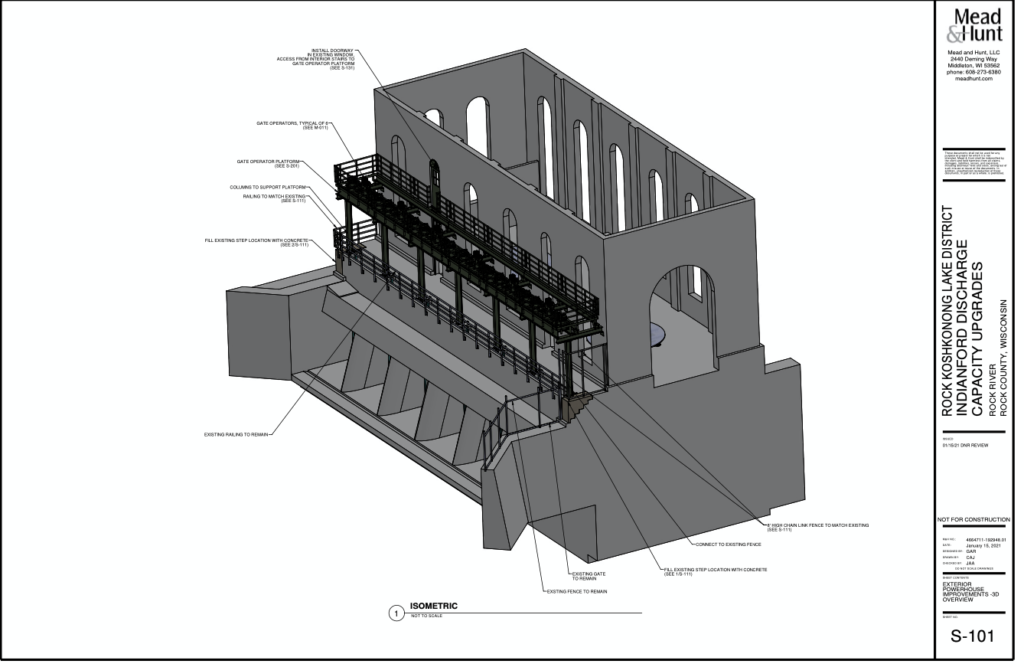
A schematic provided by Mead and Hunt shows new mounts for six slide gates that will operate on the north or upriver side of the Indianford Dam powerhouse. The gates will function in replacement of wicket gates that will be removed from underneath the powerhouse.
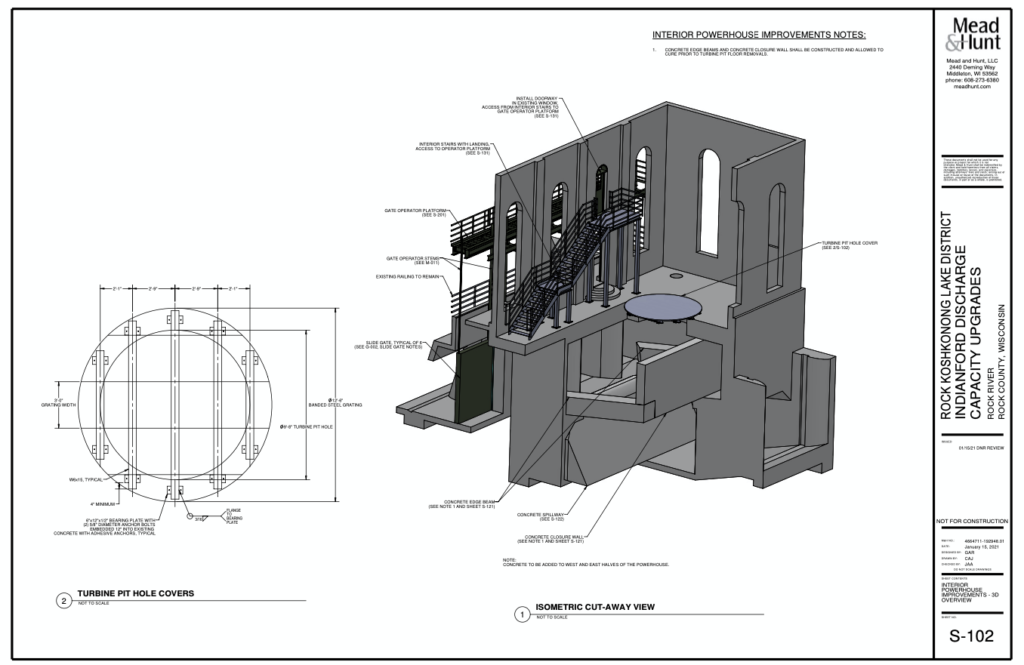
A schematic provided by Mead and Hunt shows new turbine pit covers that will be placed over two points which formerly allowed access to the wicket turbines housed under the powerhouse. Once the wicket gates are removed, water will be controlled by six slide gates mounted on the upstream side of the building. The schematic also shows an interior staircase that will be erected at the powerhouse to allow operators access to the slide gate mounts.
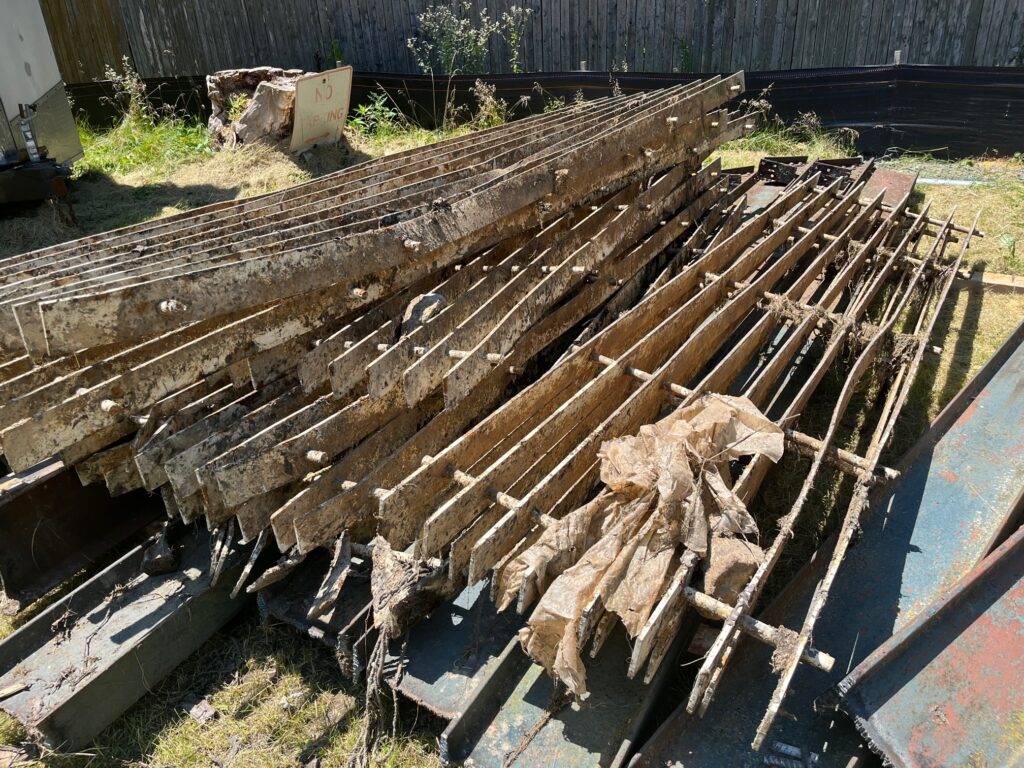
Trash racks used to keep debris from entering the wicket gate turbines are removed from the powerhouse. A floating boom, configured to move debris over the dam’s spillway, will be used to help keep slide gates free from debris. Contributed photo.
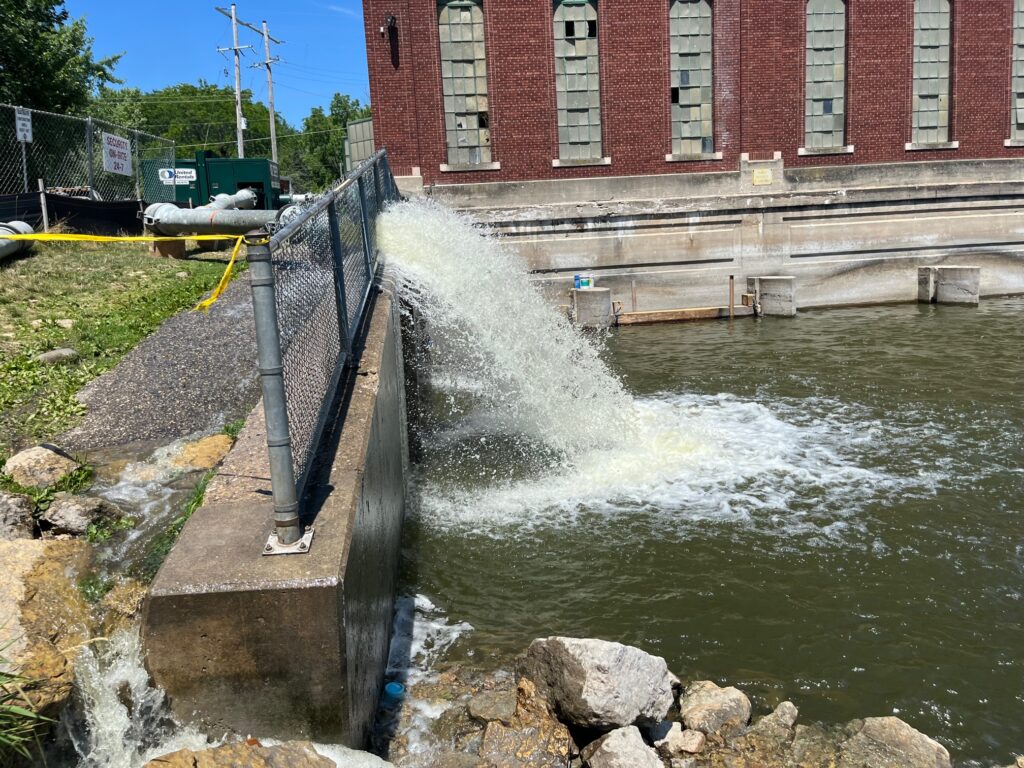
A “dewatering” process removes river water from the wicket gate turbine pit, allowing workers to enter the space. Contributed photo.
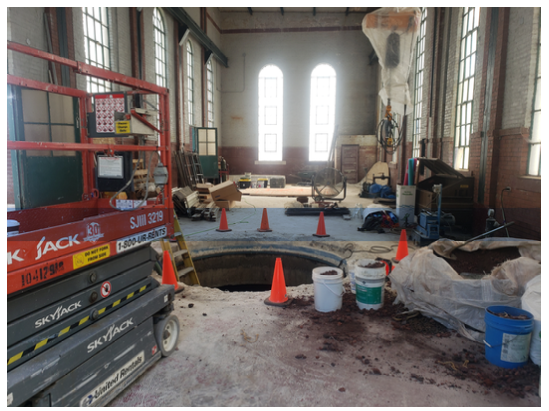
A view inside the Indianford Dam powerhouse. Contributed photo.
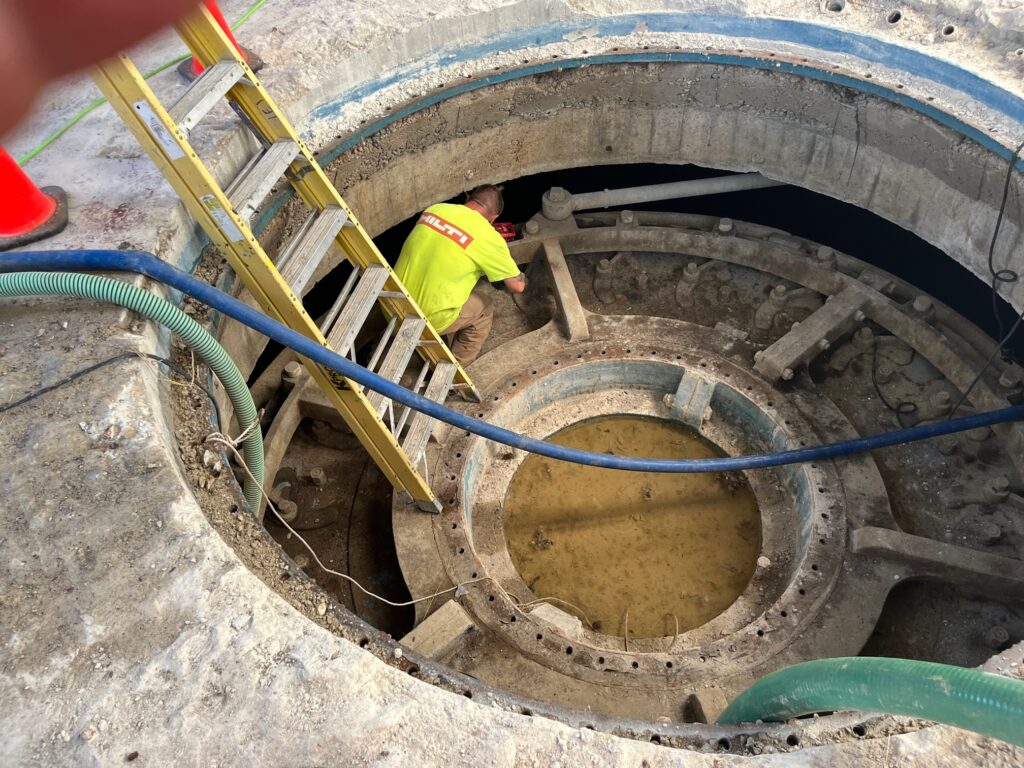
A worker stands on the top of a wicket gate which is positioned underneath the powerhouse floor. Contributed photo.
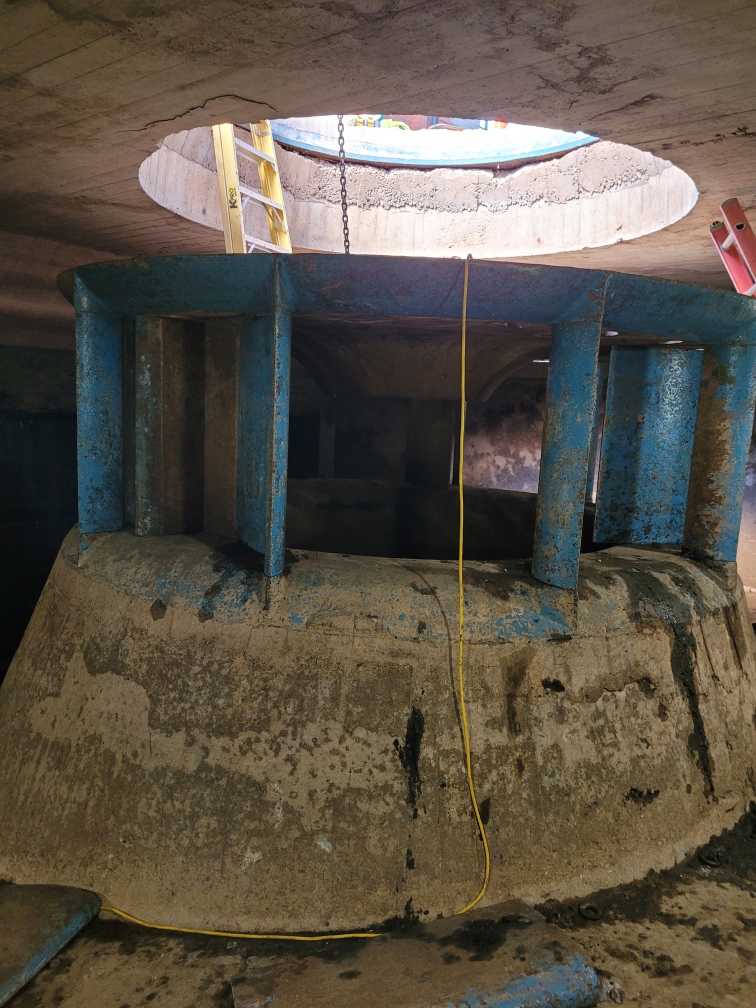
After dewatering, a wicket gate is brought into view inside one of the two cavities underneath the Indianford Dam. The gate, shown in blue, is one of two that will be removed and replaced with slide gates as part of the project that is underway. Concrete curbing underneath the gate will be removed, and concrete will be poured between the cavity ceiling and the powerhouse floor above to strengthen the structure and keep water from entering the powerhouse. Contributed photo.
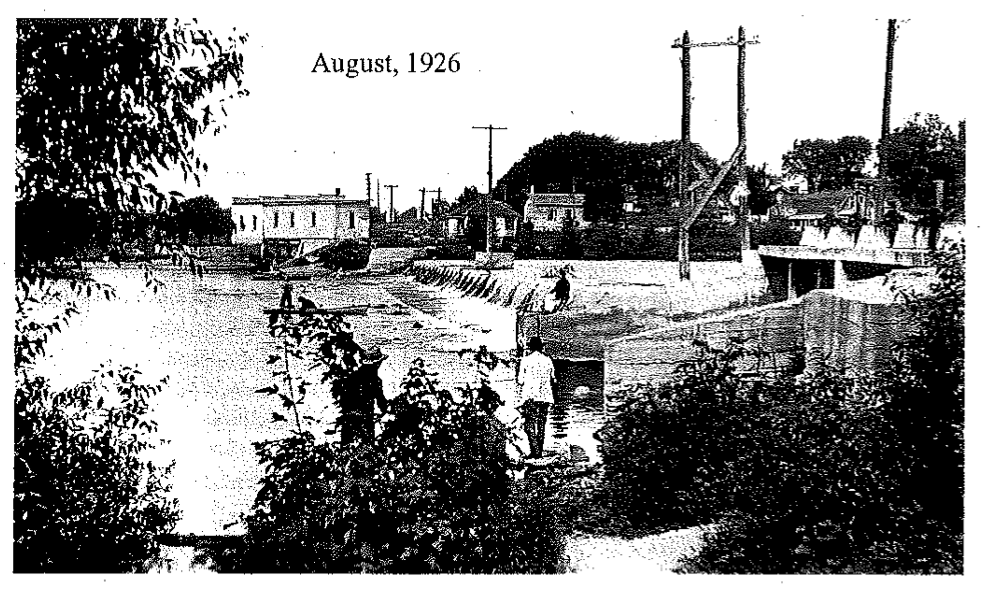
The Indianford Dam pictured in 1926. The photo appears in the DNR document titled: “Environmental Assessment: On Petition of the Rock-Koshkonong Lake District Amend Order 3-SD-82-809, Regarding the Indianford Dam and Lake Koskinong Water Levels.”
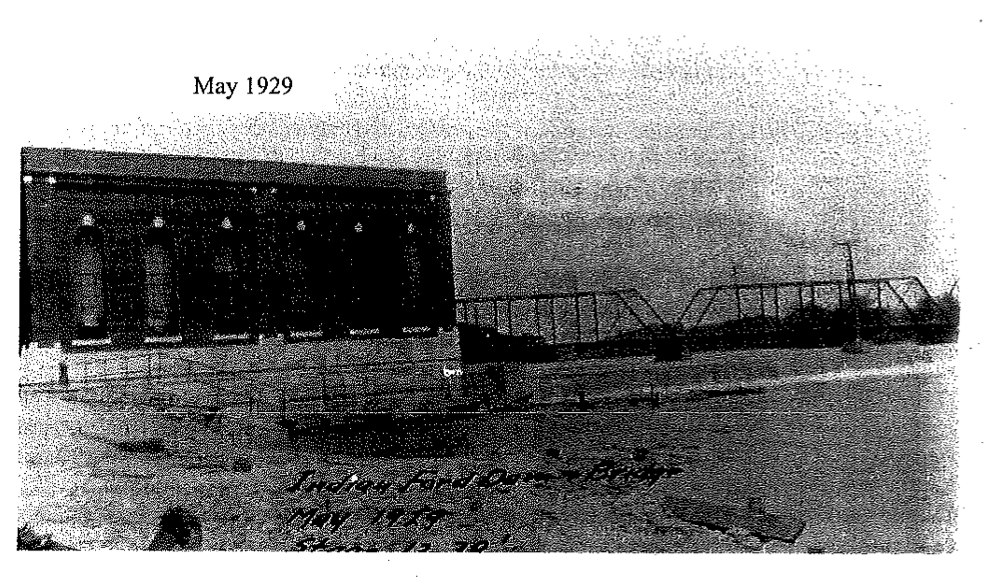
The Indianford Dam powerhouse pictured in May of 1929, which, according the Wisconsin Historical Society’s website, is one year after it was built. The picture appears in the DNR document titled: “Environmental Assessment: On Petition of the Rock-Koshkonong Lake District Amend Order 3-SD-82-809, Regarding the Indianford Dam and Lake Koskinong Water Levels.”
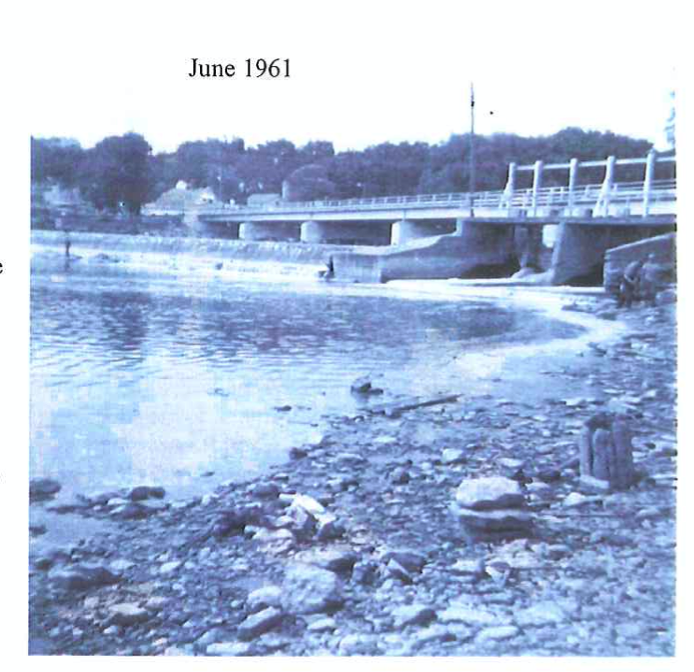
The Indianford Dam as pictured in 1961. The photo appears in the DNR document titled: “Environmental Assessment: On Petition of the Rock-Koshkonong Lake District Amend Order 3-SD-82-809, Regarding the Indianford Dam and Lake Koskinong Water Levels.” The full document is here: https://dnr.wi.gov/topic/dams/documents/indianford/EA2005.pdf.
This post has already been read 2935 times!
